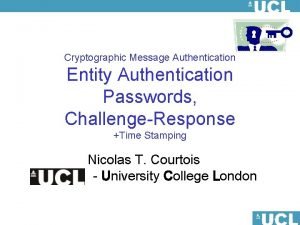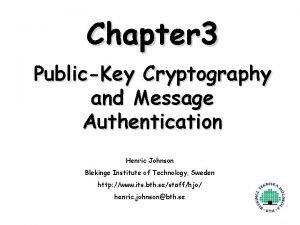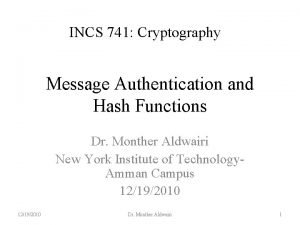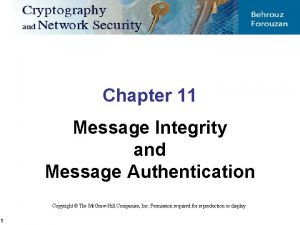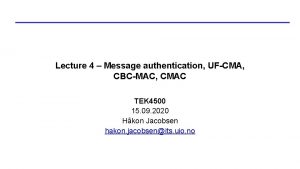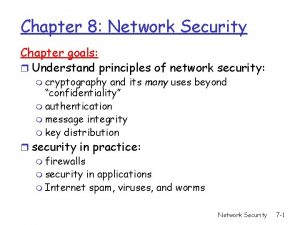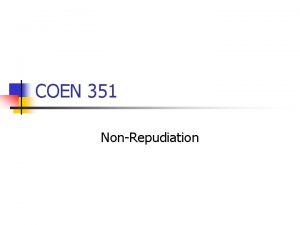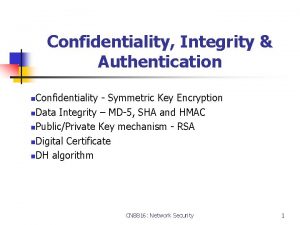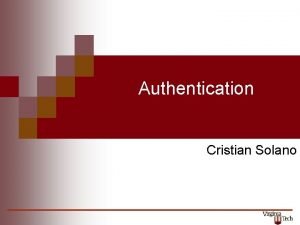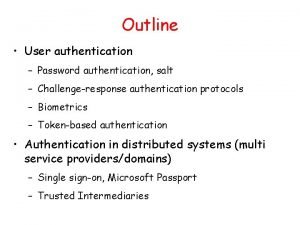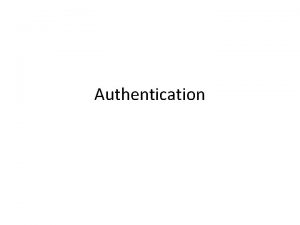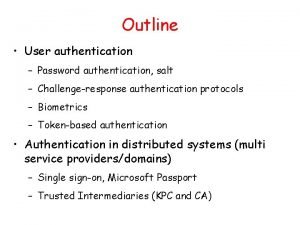Goals of Cryptography Confidentiality Data integrity Authentication Nonrepudiation















- Slides: 15

Goals of Cryptography • • Confidentiality Data integrity Authentication Non-repudiation

Classify Security Attacks as • passive attacks - eavesdropping on, or monitoring of, transmissions to: – obtain message contents, or – monitor traffic flows

Passive Attacks

Active attacks • active attacks – modification of data stream to: – – masquerade of one entity as some other replay previous messages modify messages in transit denial of service

Active Attacks

Model for Network Security

Symmetric Cipher Model

Requirements and assumptions • two requirements for secure use of symmetric encryption: – a strong encryption algorithm – a secret key known only to sender / receiver Y = EK(X) X = DK(Y) • assume encryption algorithm is known. Kerckhoff principle • assume that secret key is known only to sender and receiver

Private-Key Cryptography • Up to know we considered a traditional private/secret/single key cryptography when the same key is shared by both sender and receiver • If this key is disclosed communications are compromised • It is called also symmetric since parties are equal in the sense that they share the same key hence does not protect sender from receiver forging a message & claiming is sent by sender

Public-Key Cryptography • public-key/two-key/asymmetric cryptography involves the use of two keys: – a public-key, which may be known by anybody, and can be used to encrypt messages, and verify signatures – a private-key, known only to the recipient, used to decrypt messages, and sign (create) signatures • is asymmetric because – those who encrypt messages or verify signatures cannot decrypt messages or create signatures

Public-Key Cryptography

Diffie-Hellman Setup • all users agree on global parameters: – large prime integer or polynomial q – α a primitive root mod q • each user (eg. A ) generates their key – chooses a secret key (number): x. A < q x. A – compute their public key: y. A = α mod q • each user makes public that key y. A


Diffie-Hellman Key Exchange • shared session key for users A & B is KAB: x. A ∙ x. B KAB = α mod q x = y. A B mod q (which B can compute) x. A = y. B mod q (which A can compute) • KAB is used as session key in private-key encryption scheme between Alice and Bob • if Alice and Bob subsequently communicate, they will have the same key as before, unless they choose new public-keys • In order to get a session key attacker must solve discrete log problem

Diffie-Hellman Example • users Alice & Bob who wish to swap keys: • agree on prime q=353 and α=3 • select random secret keys: – A chooses x. A=97, B chooses x. B=233 • compute public keys: 97 – y. A = 3 mod 353 = 40 233 – y. B = 3 mod 353 = 248 (Alice) (Bob) • compute shared session key as: x. A 97 KAB= y. B mod 353 = 248 = 160 x. B 233 KAB= y. A mod 353 = 40 = 160 (Alice) (Bob)
 Peer entity authentication
Peer entity authentication Confidentiality integrity availability
Confidentiality integrity availability Strategic goals tactical goals operational goals
Strategic goals tactical goals operational goals Strategic goals tactical goals operational goals
Strategic goals tactical goals operational goals Message authentication and entity authentication
Message authentication and entity authentication Authentication in cryptography and network security
Authentication in cryptography and network security Public key cryptography and message authentication
Public key cryptography and message authentication Authentication functions in cryptography
Authentication functions in cryptography Message integrity
Message integrity Ufcma
Ufcma Cryptography security goals
Cryptography security goals Vigenere definition
Vigenere definition Cryptography goals
Cryptography goals General goals and specific goals
General goals and specific goals Examples of generic goals and product-specific goals
Examples of generic goals and product-specific goals Julia lane coleridge
Julia lane coleridge




